IAI Lavi
 The IAI Lavi (lion cub in Hebrew) was a multi billion dollar project that was allegedly disbanded under preasure from the US Governmant.
The IAI Lavi (lion cub in Hebrew) was a multi billion dollar project that was allegedly disbanded under preasure from the US Governmant.The prototype fighter jet developed was put on display for photographers and was never heard of or spoken about again.

The project began in February 1980, when the Israeli government authorized the IAF to present it with a list of technical specifications for the development of the IAF's future fighter. The development stage began in October 1982, with the choice of a Pratt & Whitney engine already having been made.
One of the Lavi's most distinct advantages is its functional features, especially its cockpit, custom-built entirely using input from active IAF fighter pilots. Drawing on their operational experience, the design was geared to let the pilot handle the tactical aspects of the battle, without having to worry about monitoring and controlling the various subsystems. The avionics of the Lavi were considered to be innovative and groundbreaking, and included self-analysis equipment to make maintenance easier.
About three months later, a second prototype took to the air. In its maiden flight, the engine systems, flight control, electrical system, hydraulics and air conditioning were evaluated. The second prototype had some improvements over the first, with a belly-mounted fuel tank, a special midair refuelling pipe and several avionic systems that were not employed in the first prototype.
The IAI had produced three prototypes out of the originally-planned five when the Israeli government decided to cancel the project because of budget problems and bickering among various economic and political pressure groups. The total cost for the development and production of the Lavi was $6.4 billion U.S. in 1983, around 40 percent of which was paid by the U.S. government. The project was canceled in part because the U.S. was not prepared to finance an aircraft that would compete in the export market with the F-16C/D and the F/A-18C/D, and also because a dispute arose as to the final cost. The Israeli government was unable to finance the project alone and canceled it on August 30, 1987. The decision to cancel was approved with a majority of only one vote.
Specifications
General characteristics:
Length: 14.57 m (47 ft 10 in)
Wingspan: 8.78 m (28 ft 10 in)
Height: 4.78 m (15 ft 8 in)
Wing area: 33.0 m² (355 ft²)
Empty weight: 7,031 kg (15,500 lb)
Loaded weight: 9,991 kg (22,025 lb)
Max takeoff weight: 19,277 kg (42,500 lb)
Powerplant:
1× Pratt & Whitney PW1120 afterburning turbofan, 91.5 kN (20,600 lbf)
Performance:
Maximum speed: 1,965 km/h (1,220 mph)
Range: 3,700 km (2,300 mi)
Service ceiling: 15,240 m (50,000 ft)
Rate of climb: 254 m/s (50,000 ft/min)
Thrust/weight: 0.94
Armament:
1x 30 mm DEFA cannon
7,260 kg (16,000 lb)
Links:
www.aerospaceweb.org
aircraftstories.free.fr
www.geocities.com/TimesSquare/Cavern/6130/iafm_lavi.htm
www.combatsim.com
(Adapted from http://www.wikipedia.org/ )
Labels: aircraft, aviation, cockpit, dreamhost promocode, F-16C/D, F/A-18C/D, fighter jet, IAF, IAF fighter pilots, IAI Lavi, Lavi, links, lion cub, Pratt Whitney PW1120, prototype





0 Comments:
Post a Comment
<< Home